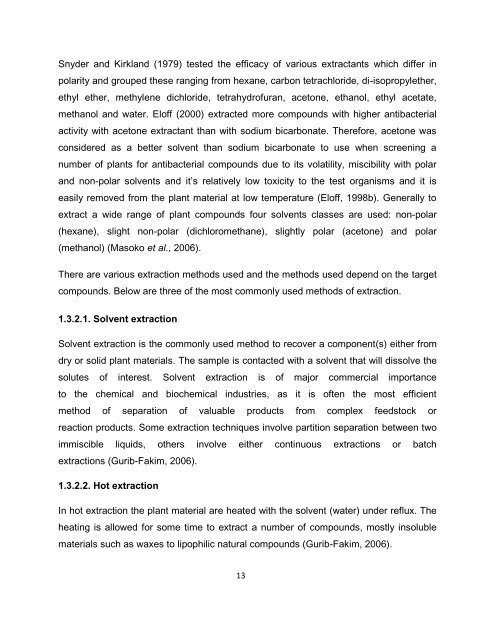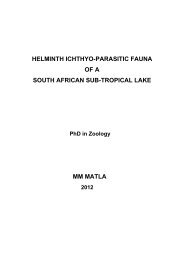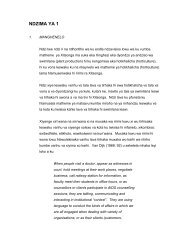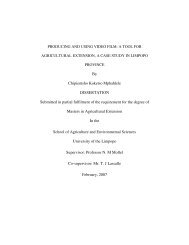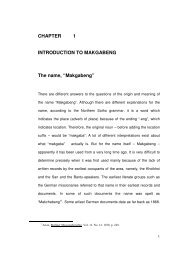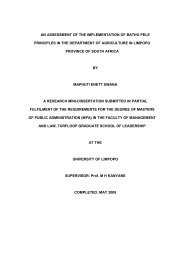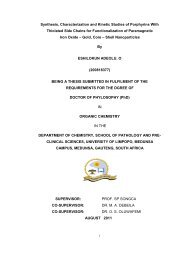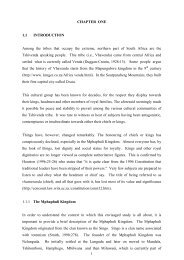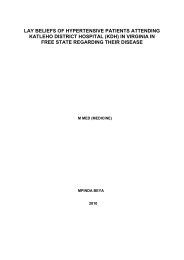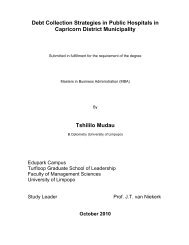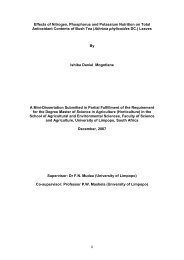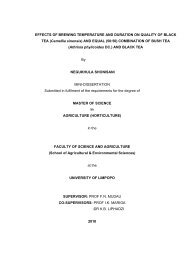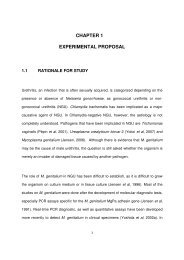Mmushi T MSc (Microbiology).pdf
Mmushi T MSc (Microbiology).pdf
Mmushi T MSc (Microbiology).pdf
You also want an ePaper? Increase the reach of your titles
YUMPU automatically turns print PDFs into web optimized ePapers that Google loves.
Snyder and Kirkland (1979) tested the efficacy of various extractants which differ in<br />
polarity and grouped these ranging from hexane, carbon tetrachloride, di-isopropylether,<br />
ethyl ether, methylene dichloride, tetrahydrofuran, acetone, ethanol, ethyl acetate,<br />
methanol and water. Eloff (2000) extracted more compounds with higher antibacterial<br />
activity with acetone extractant than with sodium bicarbonate. Therefore, acetone was<br />
considered as a better solvent than sodium bicarbonate to use when screening a<br />
number of plants for antibacterial compounds due to its volatility, miscibility with polar<br />
and non-polar solvents and it’s relatively low toxicity to the test organisms and it is<br />
easily removed from the plant material at low temperature (Eloff, 1998b). Generally to<br />
extract a wide range of plant compounds four solvents classes are used: non-polar<br />
(hexane), slight non-polar (dichloromethane), slightly polar (acetone) and polar<br />
(methanol) (Masoko et al., 2006).<br />
There are various extraction methods used and the methods used depend on the target<br />
compounds. Below are three of the most commonly used methods of extraction.<br />
1.3.2.1. Solvent extraction<br />
Solvent extraction is the commonly used method to recover a component(s) either from<br />
dry or solid plant materials. The sample is contacted with a solvent that will dissolve the<br />
solutes of interest. Solvent extraction is of major commercial importance<br />
to the chemical and biochemical industries, as it is often the most efficient<br />
method of separation of valuable products from complex feedstock or<br />
reaction products. Some extraction techniques involve partition separation between two<br />
immiscible liquids, others involve either continuous extractions or batch<br />
extractions (Gurib-Fakim, 2006).<br />
1.3.2.2. Hot extraction<br />
In hot extraction the plant material are heated with the solvent (water) under reflux. The<br />
heating is allowed for some time to extract a number of compounds, mostly insoluble<br />
materials such as waxes to lipophilic natural compounds (Gurib-Fakim, 2006).<br />
13


